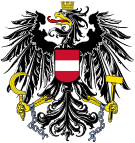| |||||||||||||||||||||||||||||||||||||||||
165 seats in the National Council of Austria 83 seats needed for a majority | |||||||||||||||||||||||||||||||||||||||||
|---|---|---|---|---|---|---|---|---|---|---|---|---|---|---|---|---|---|---|---|---|---|---|---|---|---|---|---|---|---|---|---|---|---|---|---|---|---|---|---|---|---|
| |||||||||||||||||||||||||||||||||||||||||
 Results of the election, showing seats won by constituency and nationwide. Constituencies are shaded according to the first-place party. | |||||||||||||||||||||||||||||||||||||||||
| |||||||||||||||||||||||||||||||||||||||||
| This article is part of a series on the |
| Politics of Austria |
|---|
 |
Parliamentary elections were held in Austria on 18 November 1962.[1] The result was a victory for the Austrian People's Party, which won 81 of the 165 seats. Voter turnout was 94%.[2] Although the People's Party had come up only two seats short of an outright majority, Chancellor Alfons Gorbach (who had succeeded Julius Raab a year earlier) retained the grand coalition with the Socialists under Vice-Chancellor Bruno Pittermann.
- ^ Nohlen, Dieter; Stöver, Philip (31 May 2010). Elections in Europe: A data handbook. Nomos Verlagsgesellschaft. p. 196. ISBN 978-3-8329-5609-7.
- ^ Nohlen & Stöver, p214




